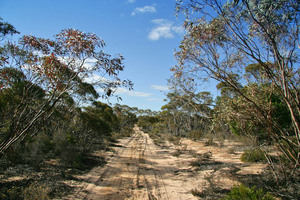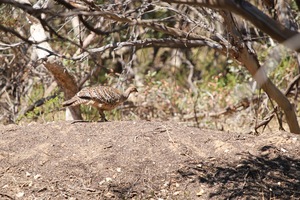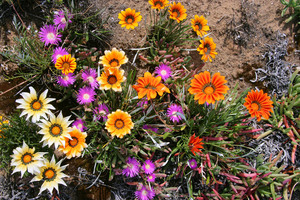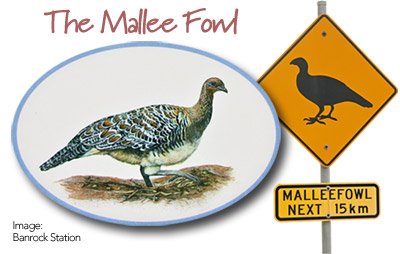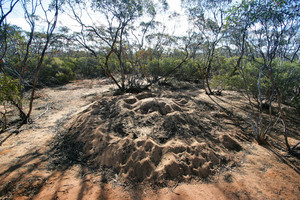
Along the Mallee Highway you'll find a large range of National and Conservation Parks. These include the Ngarkat complex of parks, the adjoining Big Desert and Wyperfeld Parks in Victoria, the Murray-Sunset National Park and the Billiatt, Peebinga, Carcuma and Karte Conservation Parks in South Australia which represent a rich legacy of the original environment. The Mallee parks offer visitors a subtle beauty and sensitive landscape to explore.
-
Nature & Wildlife
• The Mallee Landscape
• The Mallee Fowl
• Watching Wildlife
• Mallee Flowers
• The Honeydrippers
• The Precious Mallee Fowl
• 4 Wheel Driving
• Visitor Information - South Australian Mallee Parks
• Ngarkat Conservation Park
• Box Flat
• Pertendi Hut
• Pine Hut Soak
• The Border Track
• Baan Hill
• Billiatt Conservation Park
• Karte Conservation Park
• Peebinga National Park
• Parks Code
• Tracks of the Mallee - Victorian Mallee Parks
• Big Desert Wilderness Park
• Wyperfeld National Park
• Murray-Sunset National Park
• Pink Lakes
• 4WD in Victoria Parks
• Fire Safety
• Traditional Owners
• Track Classifications
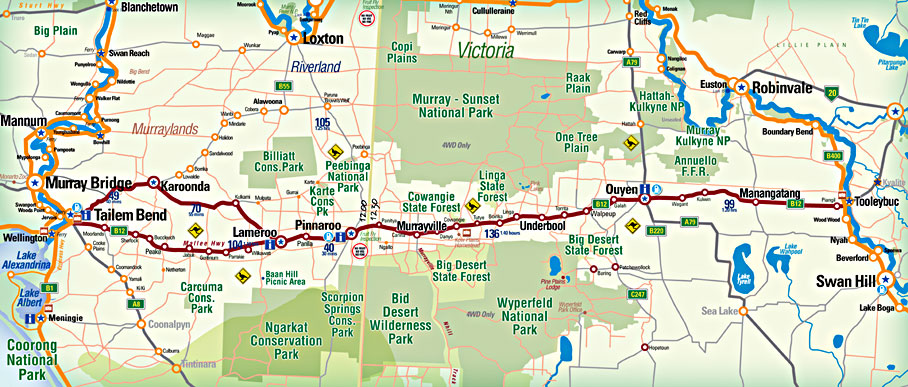
Mallee ecosystems are characterised by, and take their name from, small, multi-stemmed mallee trees mostly 5 - 8m tall, over a variable understory of shrubs, and perennial, annual and ephemeral grasses and herbs. Rainfall varies from 250 to 380mm a year. About 35% of all Mallee has been permanently cleared for agriculture, urban development or mining. Much of the remaining mallee vegetation grows on fragile sandy soil. The plant cover helps stabilise the sandy soils.
The mallee themselves display one of the most impressive adaptive features in the form of the confusingly named mallee root. The mallee root is not a root at all but is essentially a contracted underground trunk which grows just below the soil surface and from which the stems arise. It stores carbohydrates, essential nutrients and some water so that the mallee can survive long periods without rain. It's new shoots draw the carbohydrates and nutrients should the above-ground parts of the plant be destroyed by fire or other events. The mallee protects the trunk from fire and is more energy and water efficient. Some trees reach over 1000 years old.
The mallee holds a rich variety of wildlife from a myriad of insects through to the large Emus and Western Grey Kangaroos. While much of the wildlife can be hard to see there are a few techniques that will assist you to view some of these elusive animals. Always remember to:
• Stay on the trail
• Put the animals’ welfare first
• Move slowly and quietly
• Observe from a distance
• Use binoculars for a close-up view
The 1st September marks the arrival of Spring time and on that day the Nation celebrated wattle day, many of the wattles in the Mallee are now at their best, amongst these is the Golden Wattle Acacia pycantha our national floral emblem. The wet season followed by Spring time is perfect for germination of native plants in areas where the soil has been disturbed or recently burnt. You'll find flowers like Grevillia, Satin Everlasting, Black Anther Flax Lily, Variable Daisy and much more.
For more information on visit: http://www.malleebound.com.au
The banksias that grow throughout much of Ngarkat Conservation Park produce large amounts of nectar. For many years the area has been the winter home of honeybees. A number of apiarists (beekeepers) place hives among the banksias for a few months each year. As you travel around Ngarkat you may notice numerous unmarked tracks. These tracks are for servicing the beehives, and are not for public access. The network of tracks is complex, and it is very easy to become disorientated. Apart from becoming lost you will probably disturb the bees and damage vegetation as you try to find your way out. Play it safe, stay on the marked tracks.
Malleefowl, as the name suggests, live in the mallee areas of Australia and are rated as nationally endangered. Large patches of unburnt mallee in our national parks provide important habitat for these unique birds.
Unlike most birds, Malleefowl do not spend several weeks at a time sitting on eggs. Instead the eggs are buried in a sand and compost mound that produces enough heat to incubate the eggs. They dedicate up to eleven months a year caring for the nest, yet take no interest in their young once they have hatched.
Given that it’s such a long and intensive process to create the right conditions for the eggs to hatch, it would be reasonable to expect that the workload is shared between the male and female. In fact, this is not the case. The male digs and builds the mound, which is around one metre high and three metres wide. This is a complex and exhausting task. The right amount of compost has to be incorporated at the right depth. The male must wait for enough rain to wet the compost before building the upper layers of the nest. The female lays one large egg each week until she has laid 1520 eggs.
The male opens up the mound to receive each egg, then buries it to the right depth. He then regularly monitors and adjusts the nest temperature. This involves regularly ‘testing’ the sand at different depths, and scraping sand on and off the mound to keep it at a constant temperature.
The Department for Environment and Natural Resources in conjunction with community groups, monitor Malleefowl numbers and nest activity each year in parks and on private land. DENR also undertakes baiting programs to control foxes that prey upon Malleefowl and their eggs. Rabbit control is also conducted to remove competition for food.
If you would like to assist in protecting this very special Australian bird, please contact your nearest DENR office. SA Department of Environment and Natural Resources
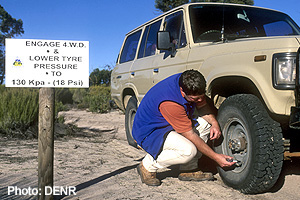
Off-Road Mallee Tracks
4 Wheel Driving – Heading off the Highway
TAKE CARE: If you get lost or your vehicle breaks down, there is no water, no passing traffic and few distinguishing features in the landscape. Temperatures can be extreme in summer and there is the risk of wildfires. Take a map, compass and water, tell someone you are going and check road conditions before you set off. Please note that vehicles are prohibited in 'wilderness' zones and 'remote' and 'natural' areas.
Note: Regular fuel available at Mildura, Swan Hill, Ouyen, Pinnaroo, Tailem Bend and Balranald
FIRE DANGER SEASON: Usually 1 November to 30 April.
(Check CFS hotline 1300 362 361) Wood fires are not permitted throughout the fire danger season. Total Fire Bans are broadcast.
The
Border Track is normally closed through the fire seasons for visitor safety.
-
Border Track and Parks Information
Mallee District National Parks and Wildlife SA - Lameroo Office
For Ngarkat, Billiatt, Karte and Peebinga Parks
Phone: (08) 8576 3690 - Parks Victoria
Phone: 13 1963
www.parkweb.vic.gov.au
Department of Sustainability
and Environment 13 6186
www.dse.vic.gov.au - Emergency Services
Ambulance: 000
Police: Pinnaroo - (08) 8577 8077
Police: Ouyen - (03) 5092 2502
Lameroo Hospital: (08) 8576 4600
Ouyen Hospital: (03) 5092 1111
RAA / RACV: 13 11 11
-
Nature & Wildlife
• The Mallee Landscape
• Watching Wildlife
• Mallee Flowers
• The Honeydrippers
• The Precious Mallee Fowl
• 4 Wheel Driving
• Visitor Information - South Australian Mallee Parks
• Ngarkat Conservation Park
• Box Flat
• Pertendi Hut
• Pine Hut Soak
• The Border Track
• Baan Hill
• Billiatt Conservation Park
• Karte Conservation Park
• Peebinga National Park
• Parks Code
• Tracks of the Mallee - Victorian Mallee Parks
• Big Desert Wilderness Park
• Wyperfeld National Park
• Murray-Sunset National Park
• Pink Lakes
• 4WD in Victoria Parks
• Fire Safety
• Traditional Owners
• Track Classifications







